A swimming pool is a great source of relaxation, exercise, and fun. However, keeping a pool clean can be a challenge, especially when it comes to pool tile cleaning. Over time, pool tiles can accumulate dirt, grime, and other contaminants that make them look dull and unsightly. Pool tile restoration is a must as the weather starts to warm and pools are filled with water. Keep reading to see different pool tile cleaning methods and how easy pool tile restoration can be when you choose Dustless Blasting.
Different Pool Tile Cleaning methods
- Scrubbing with a pool tile brush: If you're looking for an inexpensive but time consuming method, you can go with the manual method of cleaning the pool tiles. This involves using a pool tile brush to scrub the material with a pool tile cleaner. Be sure to wear gloves and eye protection, and work in a well-ventilated area to avoid chemical inhalation or debris injuries.
- Pressure washing: This method involves using a pressure washer to clean dirt and grime from the pool tiles. Be sure to use a low pressure setting to avoid damaging the tiles. Because a pressure washer involves water traveling at an extremely high velocity, this tool can cause unwanted wear or damage to the material you are cleaning. This tool also uses an extreme amount of water at about 120 - 240 gallons per hour.
- Chemical cleaning: There are several chemicals available for cleaning pool tiles, including muriatic acid and vinegar. The process typically involves applying the chemical solution to the tiles, letting it sit for a period of time, and then scrubbing the tiles with a brush to remove any remaining residue. it is important to use the cleaning chemicals properly and in the correct concentrations to avoid damaging the tiles or harming swimmers. Be sure to follow the manufacturer’s instructions carefully, and wear protective clothing and gloves.
- Dustless Blasting: Though this method does require an initial investment and a short learning period, the benefits for continued and versatile use of this machine are priceless. Save time and money for you or your business by making the switch to the future of pool tile cleaning and pool restoration. Keep scrolling to learn more about what a Dustless Blasting machine can do for you.
Gentle on Tile, Tough on Buildup
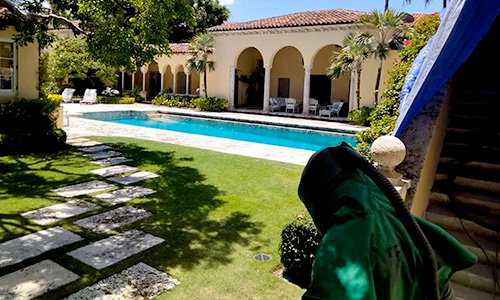
Dustless Blasting is a cleaning technique that uses a combination of water, abrasive media, and compressed air to remove unwanted contaminants from surfaces. The process involves spraying a fine mist of water and abrasive media at high pressure onto the surface being cleaned. The abrasive media removes the contaminants, while the water acts as a suppressant, preventing dust and debris from becoming airborne. You can adjust your media and blasting pressure to be sure you do no harm to delicate pool tiles. This makes Dustless Blasting a safer and more efficient cleaning method compared to traditional sandblasting.
Media for Pool Tile Cleaning
When it comes to cleaning pool tiles, Dustless Blasting is an excellent choice because it can remove a variety of contaminants, including stubborn calcium deposits, algae, and other stains. When selecting the proper media for tile cleaning, be sure to use a round abrasive, such as glass beads to leave the surface smooth. Do not use an angled abrasive when cleaning a delicate material like pool tiles. This will etch the surface and cause unwanted damage. With the proper media, the Dustless Blasting process is gentle enough not to damage the tiles but powerful enough to remove any buildup or mineral deposits. This means you can get tiles looking like new again without causing any damage to the pool itself.
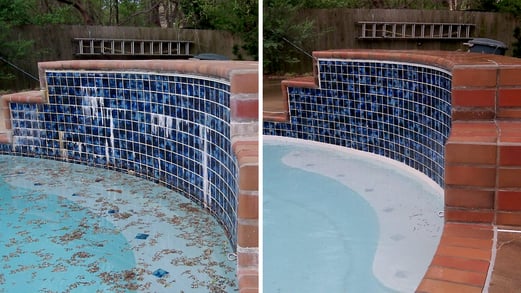
suppress dust by wet blasting
Keep the customer and neighbor's happy with the wet abrasive blasting method. This is not a typical water-only pressure washer. The Dustless Blasting machine can wet, dry, and soda blast in one, but wet abrasive blasting suppresses potentially harmful dust plumes and keeps debris from traveling airborne to nearby houses, making it the perfect solution for residential areas. Another benefit of Dustless Blasting is that it is environmentally friendly. The water used in the process captures the abrasive media and contaminants, preventing them from entering the environment with easy containment and cleanup. Remember how we mentioned pressure washing as a pool tile cleaning method above? Compared to a pressure washer's 120-240 gallons of water output an hour, a DB500 machine outputs only 20 gallons per hour. That's less water than a 10 minute shower! This makes Dustless Blasting a great choice for those who want to minimize their impact on the environment while still restoring those pools back to their former glory.
Pool Tile Case Study
One contractor was able to make 185 linear feet of pool tile look new again in just two hours. Using glass bead media, he was able to preserve the smooth surface of the tile while blasting away thick calcium buildup, all without harming any of the landscaping around the pool area or disrupting the pH. Another advantage of using the glass bead media is the ability to reclaim the spent media to be used again in the blast pot, saving the contractor money.
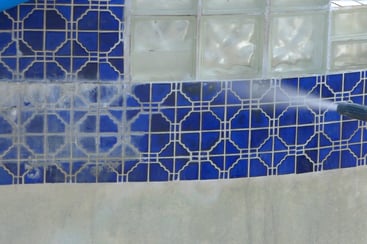
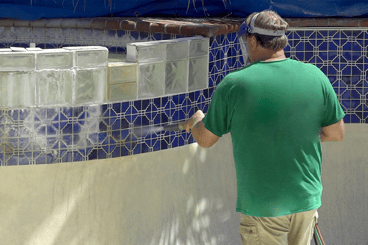
Watch the video below to see the Dustless Blaster cleaning a pool in action!
Complete Pool Restoration Solution
In addition to cleaning pool tiles, Dustless Blasting can be used to clean a variety of other surfaces, including concrete, brick, stone, metal, and plaster. This makes it a versatile cleaning method that can be used in a variety of settings, both residential and commercial, to service all of your customer's needs for the upcoming summer.
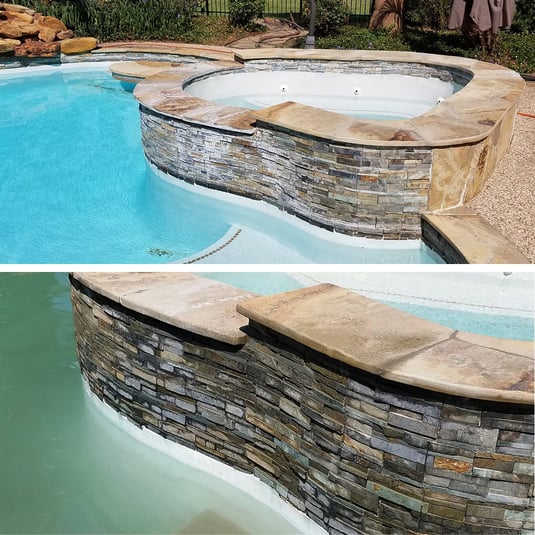
Cleaning pool tiles can be a challenging and time consuming task, but Dustless Blasting makes it easy and efficient. This method is safe, environmentally friendly, and effective at removing even the toughest stains and buildup, without the use of harsh chemicals. So, whether you're a restoration company looking to get pool tiles sparkling like new again or thinking of starting your own business, consider Dustless Blasting as a cleaning option this season.
Want to learn more about pool restoration? See the complete pool restoration guide here.